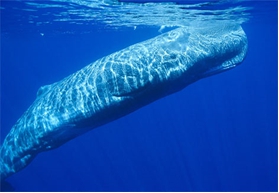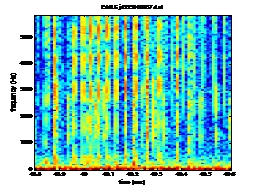Acoustical Society of America
159th Meeting Lay Language Papers
Clicking Whales - Who is Speaking?
George E. Ioup - gioup@uno.edu
Juliette W. Ioup
Lisa A. Pflug
Department of Physics, University of New Orleans
New Orleans, LA 70148
Natalia A. Sidorovskaia
Philip Schexnayder
Physics Department, University of Louisiana at Lafayette
Lafayette, LA
Christopher O. Tiemann
Alan Bernstein
Applied Research Laboratories, University of Texas at Austin
Austin, TX
Popular version of papers 5aAB3 and 5aAB4
Presented Friday morning, April 23, 2010
159th ASA Meeting, Baltimore, MD
Toothed whales (odontocetes), including sperm and beaked whales, emit very loud clicks into the water. They do this in order to echolocate: they listen to the echoes from the surface and the bottom to know where they are in the water column, and they listen to echoes from their prey in order to locate their food. A fascinating research question is whether whales can tell which of their comrades is clicking from subtle differences in the clicks emitted by each whale. There are evolutionary advantages to being able to identify the speaker. As examples, 1) calves can recognize their mothers, and 2) the animals can synchronize their dives, which they do. A very interesting related question is whether humans who are also listening can identify each whale from the properties of their clicks. Sperm whales, which have very large heads (up to 20 ft long) and emit extremely loud clicks, are especially intriguing because they also emit clicks which are thought to be for communication purposes. A group of these clicks, called a coda, is 6 to 15 clicks in a row spanning about half a second. Beaked whales, which are often very shy and difficult to see since they rest below the surface instead of at the surface, are especially intriguing. Although their echolocation clicks are more difficult to use for individual identification, we are also making progress for these clicks.
We study both the time properties of the individual clicks and also their properties after they are analyzed into component waves of different frequencies (the way the human ear analyzes sounds). These techniques, collectively referred to as cluster analysis, associate similar codas or echolocation clicks with each other assuming similar clicks come from the same whale, and results so far are promising. What is needed is a way to know if our associations do indeed correspond correctly to individual whales. Therefore, we have begun to locate the whales acoustically at the same time we are identifying them, thus confirming that clicks do come from the same whale. If our identifications of individual whales are verified, the research can have significant benefit both for behavioral studies of the whales and for population estimation.
We now have a summary of possible acoustic cues that may be used both by whales and by humans to identify individuals. It is likely that the whales use more than one of these cues and they may use all of them. It is also likely that in many situations humans will need to use more than one of these cues simultaneously to identify individuals.
Single click properties in time and frequency
- humans can use cluster analysis to sort clicks
Acoustic localization
Interval between echolocation clicks
- humans can use cadence analysis to distinguish click trains
Rhythm of coda clicks
- an African drum master can possibly identify speakers or humans can develop an expert system to do it
Time evolution of clicks
- humans can develop click change detection

Figure 1. Sperm whale

Figure 2. Analysis of the clicks of one coda into waves of different frequencies. Clicks are vertical lines plotted versus time on the horizontal axis. The vertical axis shows the frequency. The color shows the contribution of waves at each frequency. Red corresponds to the most intense and blue to the least intense. Notice that the pattern versus frequency persists across all clicks in the coda. Other codas have clicks which are similar to each other and can either be the same or different from these.

Figure 3. Amplitude (pressure received at the hydrophone) plotted versus time for different clicks within one coda. The vertical axis is offset for each click so that they can be viewed more clearly. The clicks are similar to each other. Other codas have clicks which are similar to each other and can either be the same or different from these.


